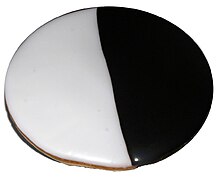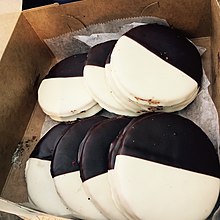Black and white cookie
 | |
| Alternative names | Half-and-half cookie |
|---|---|
| Type | Cookie |
| Course | Dessert |
A black-and-white cookie, half-and-half cookie, or half-moon cookie is a round cookie iced or frosted on one half with vanilla and on the other with chocolate. In the German language they are called Amerikaner. There are regional differences: a black-and-white cookie is flat, has royal icing on a denser cake base, and is common in New York City, while a half-moon cookie is slightly dome-shaped, has frosting on a fluffier cake base, and is common in Central New York and Boston.[1][2][3] Often one side is frosted higher than the other. Black-and-white cookies may also be found with fondant instead of frosting. In Italian-American bakeries in New York City, a thin layer of apricot jam is sometimes present below the fondant.[4]
History[]


Designs with contrasting light and dark parts were popular at the turn of the 19th century, including on baked goods and desserts. Cookies with cake bases also became popular at the time. Culinary historian Stephen Schmidt sees black-and-whites and half-moons as a straightforward convergence of the two trends, and compares them to teacakes served in the Southern United States.[4] The black-and-white cookie in New York City is commonly traced to Glaser's Bake Shop, founded in 1902 by Bavarian immigrants in the Yorkville neighborhood of Manhattan.[note 1] The black-and-white cookie was among the original recipes used by the bakery.[5] Half-moon cookies can be traced instead to Hemstrought's Bakery in Utica, New York, who started baking half-moons around 1925.[note 2][6][7]
By the post-war period, black-and-white cookies had become part of American Ashkenazi Jewish culinary repertoire, deeply rooted in the Jewish communities of New York City and elsewhere around the United States.[8][9] The cookies are a fixture at many Jewish bakeries, including Moishe's Bake Shop[4] and William Greenberg’s Desserts.[8]
The origin and name of Amerikaner in Germany is unclear, as is their relationship to German baking. Purported explanations include a corruption of the word Ammoniumhydrogencarbonat (ammonium bicarbonate, a leavening agent), or that the cookie was introduced or reintroduced to Germany by American GIs in the 1950s.[10] German Amerikaner are often frosted entirely in white frosting.[11] In the former East Germany, due to anti-American sentiment, the name Ammonplätzchen (Ammonia cookies) was used.[12]
As a racial metaphor[]
In the 1994 Seinfeld episode "The Dinner Party", Jerry eats a black-and-white cookie while waiting in a New York City bakery with Elaine. He uses the cookie as a metaphor for racial harmony, saying the chocolate and vanilla represent black and white people living together and if they mix together well on a cookie they can do the same in society, suggesting the answer to poor race relations is to "Look to the cookie!"[13] Barack Obama dubbed them Unity Cookies when visiting a deli in Hollywood, Florida while campaigning in the 2008 United States presidential election.[14][15] However, African-American Rabbi Shais Rishon wrote that the cookie, with its cleanly separated black and white sides, better represented racial segregation.[16]
See also[]
Notes[]
- ^ Not to be confused with the village of Yorkville near Utica in Central New York.
- ^ Hemstrought's began business in 1920, but does not appear to have baked half-moon cookies before 1925.
References[]
- ^ Sietsema, Robert (May 19, 2015). "New York in a Dozen Dishes". Houghton Mifflin Harcourt. pp. 279–290. ISBN 9780544453630.
- ^ "The History of the Half Moon / Black and White Cookie". Driving Inertia. February 19, 2013. Retrieved July 12, 2021.
- ^ "Halfmoon Cookies". Saveur. October 13, 2000. Retrieved July 12, 2021.
- ^ a b c Spataro, Joanne. "The Real History of Black and White Cookies". VICE. Vice Media Group. Retrieved November 19, 2021.
- ^ Sietsema, Robert (June 2, 2014). "The Black-and-White Cookie's Curious History". Eater NY.
- ^ D'imperio, Chuck (April 14, 2015). A Taste of Upstate New York: The People and the Stories Behind 40 Food Favorites. Syracuse University Press. pp. 69–72. ISBN 9780815653233.
- ^ "Utica Bakery Home to the Original Halfmoon Cookies Celebrates 100 Years". spectrumlocalnews.com. Retrieved July 12, 2021.
- ^ a b Salzhauer, Rebecca. "An ode to the black and white cookie". The Forward. The Forward Association, Inc. Retrieved November 19, 2021.
- ^ Clark, Melissa. "Black-and-White Cookies". 100 Most Jewish Foods. Tablet Magazine. Retrieved November 19, 2021.
- ^ Honnen, Peter (2008). Alles Kokolores? Wörter und Wortgeschichten aus dem Rheinland. Cologne: Greven Verlag. p. 10. ISBN 978-3-7743-0418-5.
- ^ "WW2 Black and White Cookie". thrillist.com. Retrieved September 1, 2017.
- ^ Martin, Ahrends (1986). Trabbi, Telespargel und Tränenpavillon. Das Wörterbuch der DDR-Sprache. Munich: Heyne. p. 18. ISBN 978-3-4530-2357-4..
- ^ Roberts, Sam (2016). A History of New York in 101 Objects. Simon and Schuster. p. 137. ISBN 9781476728797.
- ^ Clark, Lesley (October 21, 2008). "Barack Obama and the black and white cookie". The Miami Herald. Retrieved May 30, 2013.
- ^ Johnson, Sasha (October 21, 2008). "Obama: McCain is 'running out of time' and 'making stuff up'". CNN. Retrieved May 30, 2013.
- ^ MaNishtana (November 11, 2015). "Black and White and Not All Right: These Cookies Must Stop!". Tablet Magazine. Retrieved November 23, 2021.
- American desserts
- Ashkenazi Jewish culture in New York City
- Ashkenazi Jewish cuisine
- Cookies
- Chocolate desserts
- Cuisine of New York City
- Cuisine of the Mid-Atlantic states
- German-American cuisine
- German-American culture in New York City
- Jewish American cuisine
- Jewish cookies
- Jewish desserts
- Shortbread
- Utica, New York
- Yorkville, Manhattan